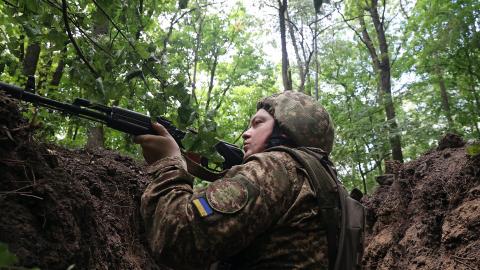Below Senior Fellow Can Kasapoğlu offers a military situation report about the war in Ukraine.
Executive Summary
• Drone-on-drone warfare is on the rise in Ukraine, offering a continuing glimpse into the future of armed conflict.
• The Ukrainian 79th Air Assault Brigade repelled a critical Russian assault, while the Russian military continued to press on multiple fronts.
• A militant group ambushed detachments of the Wagner private military company in Mali, inflicting several high-value casualties.
• Drones produced by Russia and Iran entered North Atlantic Treaty Organization (NATO) territory.
1. Battlefield Assessment
Last week Russian forces made marginal territorial gains and advances on the eastern and northeastern front lines around the towns of Niu-York, Toretsk, and Pokrovsk. Reports suggest that Ukrainian troops operating on the eastern front suffered from insufficient rotation and poor training for newly drafted fighters.
In the east, at Kurakhivka, the Ukrainian 79th Air Assault Brigade repelled a major Russian assault involving mechanized infantry and heavy armor in large numbers, hindering Moscow’s plans to cut off the urban area of Kurakhove from its supply lines in hopes of capturing the city. Meanwhile, Russian troops were filmed using electric scooters in several engagements, highlighting the vulnerability of the Kremlin’s conscripts.
Drone-on-drone warfare is also increasing across Ukraine. The Russian Defense Ministry released footage of a first-person-view (FPV) drone downing a Ukrainian Baba Yaga unmanned aerial vehicle (UAV), a nighttime bomber drone with sensors and a relatively heavy payload capacity. Russia is now prioritizing Baba Yaga UAVs as targets for its own robotic warfare assets.
Despite recent progress, Moscow’s troops remain prisoners of geography. According to some assessments, Russian units failed to complete a water crossing of the channel separating the center of Chasiv Yar from the town’s Kanal District, its easternmost neighborhood. This failure presents a window of opportunity for Ukrainian forces.
While continuing its heavy ground offensives, Russia also maintained aerial attacks on critical infrastructure in Ukraine. Last week Russian missiles and drones pounded Odesa, one of the few ports from which Ukraine can still export grain.
Ukrainian forces fought back, continuing their strike campaign against critical Russian platforms. Last weekend saw one of Kyiv’s longest-range strategic strikes to date. The strike’s target set included the Olenya airfield—an air base close to the Finnish border that hosts the Kremlin’s Tu-22M3 tactical bombers—and the last Russian military logistics ferry that remained in Crimea.
Ukraine’s strongest supporters continued to provide it with military assistance. This week Poland began to prepare its forty-fifth military aid package for Ukraine. Reports suggest that this assistance includes a significant amount of much-needed ammunition. In another positive step, Japan and the United States announced cooperative efforts to increase production of MIM-104 Patriot missiles, a move that will help bolster Ukraine’s air defense capacity. The Patriot interceptor missile is important for effective air defense in a long war.
Wreckage assessments have revealed more information on the mysterious Russian drone that the last edition of this report covered. Open-source intelligence suggests that the drone’s serial number begins with a character that could trace the UAV to the joint Russia-Iran drone production plant in Alabuga in Russian Tatarstan.
The drone also bears interesting similarities to the more recent Iran-produced variants of the Shahed-136 loitering munition, including 3G/4G antennas and a fuselage covered in radar-absorbent material. Evidence suggests that previous variants of the Shahed kamikaze drones featured a SIM card and a power bank manufactured by a Ukrainian company, Kyivstar.
2. The Wagner Private Military Company Reportedly Suffers a Big Loss in Mali
Reports this week indicated that the Arab Movement of Azawad, a militia active in northern Mali, killed numerous Russian mercenaries, including Anton Yelizarov, the field commander of the Wagner private military company’s forces in Africa.
Yelizarov played a significant role in previous Russian offensives in Ukraine, such as the assaults on Soledar and Bakhmut. The mercenary’s military experience aligned with Wagner’s needs, and he helped the group extend its reach from Ukraine to the Middle East and key African conflict zones. Prior to joining Yevgeny Prigozhin’s Wagner, Yelizarov was part of several elite units of the Russian Armed Forces, including the 7th Guards Mountain Air Assault Division of the Russian Airborne Forces (VDV) and special forces units of Russian military intelligence (GRU).
Some sources report that the attack killed Nikita Fedianin, a Russian propagandist known for administering the Wagner-linked Telegram channel Grey Zone. Visual evidence also suggests that the incident cost Wagner forces several mine-resistant ambush-protected (MRAP) vehicles and a Mi-24 helicopter.
3. The Russia-Iran Drone Threat Is Spilling across Ukraine’s Borders
Russian and Iranian drones are now threatening North Atlantic Treaty Organization (NATO) allies on Ukraine’s borders. The Ukrainian Air Force noted this week that three Russian drones entered Romania, prompting Bucharest to intercept the UAVs with Gepard self-propelled anti-aircraft guns (SPAAGs). The wreckage of a Shahed-136, also known by its Russian designation Geran-2, was found in Romania shortly after the incident.
In another sign of the broadening scope of the conflict, a kamikaze unmanned surface vehicle (USV) washed up on Türkiye’s Black Sea coast. Visual evidence suggests that the USV is a Yamaha WaveRunner personal watercraft equipped with two warheads, multiple sensors, and flotation devices on each side that make it difficult to capsize. Technical assessments suggest that the USV floated to the Turkish shore after it ran out of fuel, lost its directional guidance, or malfunctioned.



















